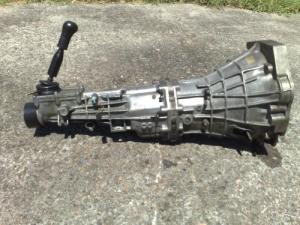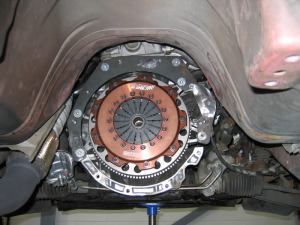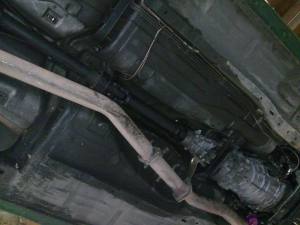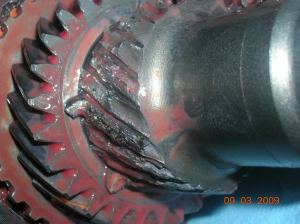If you own an SR20DET or CA18DET that’s used on track, drifted or just run hard on the street then the likelihood is that you have broken a gearbox. Failure comes in many guises, broken tail shafts, bent selector forks but the most common problem is a stripped 3rd gear. If it’s happened to you then you’ll know the familiar deafening “BANG” followed by a complete loss of drive and the sound of marbles clanging round your housing. If you’re an experienced gearbox murderer then you’ll have snatched the box into neutral the instant you heard the bang – if you’re on your first M.D.K. (name the 90’s Stallone movie for bonus points) then you’ll more than likely get it stuck in gear and it can be mighty hard to get it out.
Nissan Gearboxes
Before we look at the ro0t causes of the problems, it’s important to understand the differences and similarities between the Nissan Small Casing box (and what the we actually mean when we say “Nissan Small Casing”)
Small Casing Gearset
When we refer to “small casing” we are referring to any gearbox that came attached to the:
- SR20DET (RWD)
- CA18DET
- RB20DET
or anything that came in the:
- S13/PS13/RPS13/180sx (EDM,USDM,JDM etc)
- S14/S14a/Silvia (EDM,USDM,JDM etc)
- R32-gtst
- A31 Cefiro/Laurel etc

All small casing gearboxes have the same rear casing but different bell housings to mate up their respective engines. Subsequently a CA18DET gearbox will fit straight up to an SR20DET providing you swap the bell housing.
There are slight differences between the boxes which are fairly irrelevant to this article (the reverse gear arrangement) but the main big difference is the baffling setup on the centre plate. The early small casing boxes (S13/180/R32 versions) came with holes in the centre plate to allow oil to pass between the two sides of the case. In the S14 version some of these holes were sealed up – however the gearbox that came in the S14a was revised again and acts as a proper baffle, significantly reducing the movement of oil between the two sides of the case under acceleration/g’forces.
Why they fail
In short, they fail because owners put the boxes in situations that they were not designed to cope with. The gear set was originally designed to take circa 200hp and is solid up to 300hp (50% more than designed) but the increase in power, mixed with aftermarket plated clutches, worn bushes and increased transmission shock weakens the bearings/gears causing them to fail.
The 3rd gear issue can be attributed to its position within the gear set and its proximity to the bearing. (3rd gear is the furthest away) causing a lack of support, excessive tolerances and failure. It’s the boxes “Achilles heel” so to speak.
In a road/track car, the box (if not abused) can be reasonably stable up to 350hp/325ftlbs providing it and the rest of the drive train are in good condition and not abused. Unfortunately, in a drift car it’s a very different story –
Drifting put’s an extra-ordinary amount of pressure on a gear set. The following issues are significant contributing factors to box failure when skidding
– Transmission Shock: This is the single biggest killer of boxes <full stop> and it’s caused by slack in the drive train. When you put your foot on the accelerator the power travels down the drive train in this order – engine, clutch, gearbox, prop shaft, differential, half shafts, hubs, tyres.
Each of these drive train components are supported to the car by bushes and bolts and it’s the flex in these bushes which causes transmission shock (sometimes referred to as “lash”) In simple terms the process goes like this:
- Engine: The engine produces power and the rotational speed increases causing it (and the gearbox) to move on its mounts
- Clutch: The clutch then transfers this power to the gearbox loading up the gear set (causing more movement of the engine and gearbox)
- The Gearbox: Each gear has a very small gap between it and the next (usually filled by oil) and the distance between these gaps are controlled by the strength of the bearings. The power being transferred from the clutch causes all of these little gaps to close up instantaneously
- The Prop shaft: The gearbox sends the power out the tail shaft to the prop. The steel shaft actually has a small amount of flex built into it to absorb some of the shock.
- The Differential: The prop shaft transmits this power to the diff pinion gear which in turn transmits it to the crown and then to the half shafts. Being gears (the diff is supported in the pumpkin by bearings and the pumpkin is supported by the subframe which is mounted to the chassis by bushes) there is also lash here.
- The Half shafts & Hubs: The half shafts connect via a spine setup into the hubs which are supported by bearings.
- The Tyres: The tyres are the end of the process and are (by nature) sticky and designed to produce traction pushing the car forward.
All of these individual components have to “load up” before the power get’s transferred to the tyres and it’s the instantaneous “shock load” to these components that causes breakages. The simplest analogy would be hitting your mate in the arm with a baseball bat. If you place the bat against his arm and then push with all your might you’re going to knock him over into the mud (he’s not going to be very happy) however if you take a mighty swing and hit him in the arm with the same bat you’re going to break his arm (and put him in hospital)
– Oil Pooling: If you recall my earlier in the article I was talking about the centre plate on the later model boxes having less holes and serve as a better baffle? Well this is where I explain why that’s important. When drifting your effectively driving a big pendulum at speed and subsequently fluids naturally want to be forced backwards into the rear of the vehicle. When sideways (especially over a prolonged period of time) the gearbox oil passes through the holes in the centre plate and pools in the rear of the box, robbing the gear set of oil. This results in excess heat in the gears and the bearings and excessive wear.
– Poor Oil Choice: It’s pretty self explanator but i have seen people put some really funky piss thin oils in small casing nissan boxes. If your track driving and you want good lubrication, then fair enough but a thicker oil is going to cushion the gears more than a thin one.
How do we fix the problem?
unfortunately, there really isn’t a “fix” for the small casing gear set. It’s a gear set that was designed for 200hp and does admirably even up to 350hp in track cars (75% more than designed) but to really “fix” the problem your going to have to replace the box with something more beefy. However, extending the life of the box is possible:
Reducing the lash: As explained above, reducing transmission shock or “lash” makes a big difference to gearbox life. This can be done by upgrading all of the supporting bushes and mounts that hold the drivetrain in place. Going from front to back:
Bushes
– Subframe Bushes: I have had great success with Driftworks Polly bushes and have used them on a number of different cars. You can buy them here however if you don’t mind the noise you can also upgrade to ally solid versions here

– Differential Bushes: Solid mounting these are the way forward. Again, i would recommend Driftworks ally bush kit here

– Gearbox Mount: goes without saying that this stops your gearbox from moving about under the strain of rotation from the engine. Driftworks polly mount here

– Engine Mounts: You can either mill some solid ones out of ally/polly (like i did) or buy some super expensive Nismo/Cusco jobbies that are a bit of an upgrade from standard. If your planning on leaving them in there for 50,000 miles i would go Nismo/Cusco and you can buy them from SRB Power

Clutch
Dirty great big triple and multiplate clutches “snatch” the drivetrain (causing major shock to the system) To extend your gearbox life, i would recommend a simple 350hp capable paddle (for the cheap option) or if you want something exceptional go for something with carbon fibre plates. Carbonetic clutches are awesome (see here). The big deal with carbon clutches is that there bite increases the more they slip (totally opposite to a regular clutch) subsequently they don’t have the initial “snatch” that regular multipate clutches do and load up the drivetrain gradually (still within a fraction of a second)

Propshaft & Half Shafts
If your feeling flush – replace your drive and half shafts with carbon fibre one piece versions from The Driveshaft Shop in the states. Carbon Fibre pro shafts don’t just help because they are light and reduce the rotating mass, but they also have “flex” built into the shaft to assist in reducing transmission shock. They ARE NOT cheap – but very cool and work a treat.

Bearings
It goes without saying that replacing worn bearings in the diff makes a big difference. It’s all OEM Nissan parts that can be sourced from your local Nissan Dealership (or from Ebay USA – to save £££) However, my advice would be to not waste your time tearing down a box and replacing the bearings. It’ll cost you a fortune and it really doesn’t make a huge amount of sense when you can pickup a CA box for £50 and save your money for a conversion.
Good Oil
Now oil is one of those real points of controversy. Many people recommend the Redline Shockproof heavy gearbox oil (you can buy it here from Opie Oils) however i was always told “Run the thickest, nastiest agricultural gearbox oil you can find!” which has always served me well with prolonging the life of the small casing box. I use Comma EP85W-140 that can be found at any local motor factors. It’s simple, thick and has served me very well.

The Gearbox Conversion:
The gearbox conversion for the SR20 is the obvious answer to the problem, however finding the right box for you at an affordable price is not so easy. As track/spirited road driving and drifting have two differing requirements i’ll treat each one individually.
Track/Fast Road
For track and fast road the obvious choice is to do the swap with the “Large Casing” Nissan gear set/box that come in the R33gtt/R34gtt and Z32. Off the shelf conversions are available from the likes of Garage D and use the RB25DET large casing box and an adaptor plate. The whole conversion can be had for around £800 + fitting and includes a custom prop shaft, adaptor plate and the box. In drag and track cars the large casing box has been known to handle over 700hp. However unfortunately it also suffers from a 3rd gear weakness and oil pooling problem. On the plus side, it is a bit stronger than the SR20 box and is a really good upgrade for track/fast road SR’s of almost any power.


Drift Cars
Drift cars are a bit of a different issue. For the reasons stated above the RB25DET box still has issues blowing 3rd gear – however this doesn’t really happen untill you get over 350hp. If you make sure your transmission lash is sorted, your running a decent gear oil and clutch and you “should” be pretty much alright. If your planning on running anything over 400hp/400ftlb’s then i would advise you to persue another option.
At circa 400hp a standard S13/S14 rear sub frame will start to break half shafts with half decent tyres and an RB25 box. It’s a reasonably simple fix using GTR diff/shafts and hubs but once you have taken that weak point out of the system, your going to be having issues with blowing boxes again.
Unfortunatly at this point there are no “off the shelf” options currently available (that i know of) so it’s custom/bespoke and £££. I have been looking at using the Toyota R154 box or the T56/T6060 6 speed box out of a dodge viper (which has very similar ratio’s to the SR) however many comment that this box feels very “notchy”.
As a side note
Short shifters, Diff ratio’s and a couple of other things can also play a big part in gearbox life. I have tried to be as comprehensive as possible without making this too much of a burden to read. Hope this helps some 🙂

Murder Death Kill – Demolition Man 🙂
Hi:) when upgradding from a CA18 gbox to an SR20box(is it really a upgrade) and if so is it worth doing? And is the bellhouusing the oonly thing that needs changing?
good stuff
Nicely written!
You should include some info on after market gear sets such as:
*Are they interchangeable between all small casings – will an sr20 gear set fit in to a ca18 tranny?
*Brands and types (synchro/dog set) available.
Good job!
Hi,
The broken gear on your picture on the countershaft is the 2nd gear not the 3th. When you look at the countershaft from the front side the gears are. Drive gear-3-2-1-middle bearing-5. 4th is done by connecting the drive shaft to the main shaft. So in 4th no gears are involved. But you are right about the tolerances. So when changing bearings it is very important to change also the pilot bearing in the main drive shaft to the main shaft and also the roller bearing in the gears on the main shaft. And use upgraded bearings like NSKHPS or SKF explorer.
Regards
Hey Janko, great bit of additional info – thanks! I must admit to the photo ‘not being of my box’ 🙂 Regards. MB
Why would stiffer bushings be good for preventing failure? I would have thought softer bushings allow more dampening of the force, hence less transmission shock.